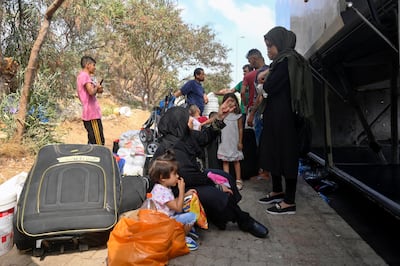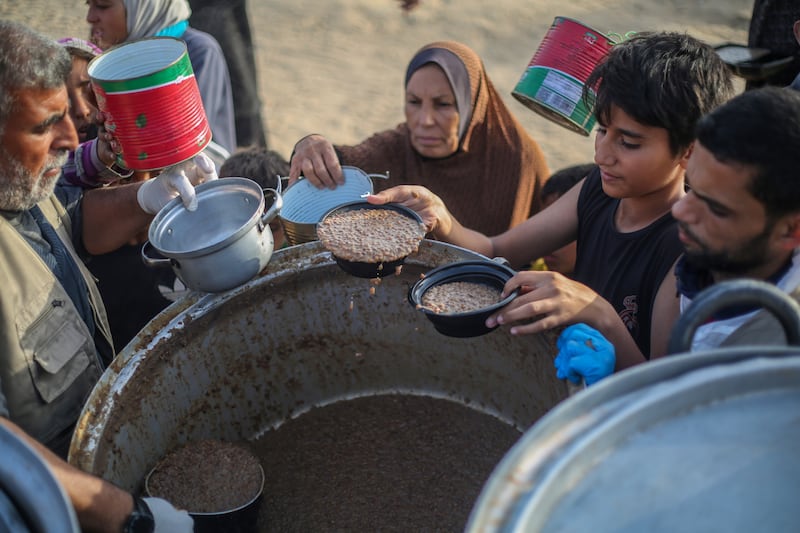Live updates: Follow the latest on Israel-Gaza
A hunger crisis facing everyone in wartime Gaza tops a list of worsening food issues affecting 37 million people in the Middle East, a report has found.
Syrian refugees in Jordan, Egypt and Lebanon are also among the hardest hit by trends of poverty, instability and soaring food prices, the UN and EU-led Global Report on Food Crises says.
It found the entire population of Gaza was at "crisis" levels, with more than a quarter at the highest "catastrophe" stage – both unprecedented proportions.
Experts fear the north of Gaza could slip into famine at "any time", potentially affecting more than a million people, between now and July.
The report, which found more than 280 million people living in high food insecurity worldwide, was described by UN Secretary General Antonio Guterres as a "roll call of human failures".
"The conflicts erupting over the past 12 months compound a dire global situation," said Mr Guterres, who addressed a launch event at the Food and Agriculture Organisation's Sheikh Zayed Centre in Rome.
"Humanity can and must do better."
Cindy McCain, head of the UN's World Food Programme, said the goal of ending global hunger by 2030 was "slipping further out of our reach".
"Conflict has plunged millions more people into acute food security in Gaza and Sudan," she said. "Famine is a real, real possibility in the months ahead."

The report said more than 500,000 people in Gaza face an "extreme lack of food, starvation and exhaustion" as hostilities with Israel continue.
That puts them at the highest "catastrophe" level on a five-tier scale, which covers 26 per cent of Gaza's population.
A full 100 per cent are in either "catastrophe" or the next two stages of "emergency" and "crisis", all of which are considered high levels of food insecurity.
Israel has repeatedly been urged to allow more aid to reach Palestinians, while efforts to broker a ceasefire have yet to bear fruit.
The report said the risk of famine increases "each day" that there is intense fighting and a lack of humanitarian access to Gaza.

It said fighting in Gaza since October had only worsened what was already a picture of high unemployment and reliance on aid in Gaza due to a prewar Israeli blockade.
Israel denies obstructing aid supplies, saying Hamas is to blame for the dire humanitarian toll and accusing aid agencies of not doing enough.
Beyond Gaza, the report warned of rising instability, growing poverty, high unemployment, soaring food prices and widespread displacement fuelling hunger across the region.
Syrian refugees were the worst affected outside Gaza – with 69 per cent of those in Jordan living in the higher tiers of food insecurity, and 62 per cent of those in Egypt.
Many refugees are living in countries going through hard economic times and funding for the Syrian crisis is dwindling, experts warn.

In Syria itself, 55 per cent are living in high food insecurity, fuelled partly by economic strife spilling over from Lebanon, where the figure is 42 per cent.
Lebanon had by far the region's highest inflation in food prices, with a rate of more than 350 per cent, coupled with fuel shortages.
While Lebanon's forecast has improved slightly for 2024, this assumes that tensions at its southern border with Israel will not escalate into a broader conflict.
Meanwhile, Yemen remains the scene of the region's biggest food crisis, with 18 million people – about 60 per cent of the population – facing acute insecurity.
The Gaza conflict is also affecting food security in the occupied West Bank, the report said, due to an increased Israeli military presence, road closures and acts of violence.
The outlook for the year "depends on whether geopolitical tensions in the region escalate and on the dynamic of hostilities in Palestine", the report said.
It warned that if regional tensions continue to rise, shipping and insurance costs in the Red Sea could further reduce food imports and push up prices.
In total, about 36.7 million people in nine countries and territories in the Middle East are facing high levels of food insecurity.
In Gaza, the conflict "makes it difficult and sometimes impossible to reach affected people", WFP official Gian Caro Cirri said.
"We need to scale up massively our assistance ... but under the current conditions, I'm afraid the situation will further deteriorate."






